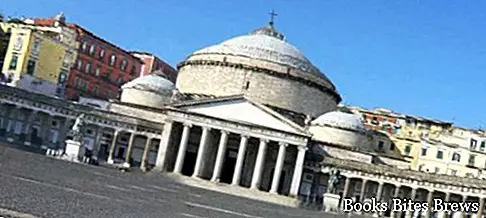What to see in Naples, 3-day itinerary including the main monuments and places of interest, including Cathedral, National Museum, Galleria Umberto I, Piazza Plebiscito and Museo Capodimonte.
Tourist information
Naples, the capital of the Campania region, is one of the most beautiful cities in Italy, with a large bay with a beautiful view of the islands of Capri and Ischia.
Around Naples there are the archaeological areas of Pompeii and Herculaneum, the ancient cities buried by a disastrous eruption of Vesuvius.
Among the splendid churches of Naples, built mainly in baroque and rococo style, and enriched with important works of art, the Cathedral dedicated to Santa Maria Assunta stands out, which houses the bones and blood of San Gennaro, patron of Naples in a crypt .
The Cathedral, built on an old early Christian church in the thirteenth century, has undergone radical alterations over the following centuries.
Next to the Cathedral is the San Gennaro Treasure Museum, which boasts an artistic and cultural heritage of great value.
In a seventeenth-century building located in Piazza Museo there is the prestigious National Archaeological Museum, where objects and artifacts ranging from prehistoric times to late antiquity, in particular from the Roman era, from various ancient sites in the South are exhibited, and from important antique collections, such as the Farnese collection that belonged to the royal dynasty of the Bourbons, founders of the Museum.
Near Piazza Dante stands the beautiful Gesu Nuovo Church, dedicated to the Immaculate Conception, full of Baroque sculptures and paintings.
Originally in its place was the Palazzo Sanseverino, which was sold to the Jesuits in 1584, and completely converted into a church by the architects Giuseppe Valeriano and Pietro Provedi, leaving only the ashlar facade of the Renaissance palace.
The body of San Giuseppe Moscati is kept inside the Church of Gesù Nuovo.
The Galleria Umberto, from the late nineteenth century, has the traditional shape of a Greek cross with a glass dome, and has always been the commercial and leisure heart of the city.
Recommended readings- Sapri (Campania): what to see
- Campania: Sunday day trips
- Amalfi (Campania): what to see
- Acciaroli (Campania): what to see
- Teano (Campania): what to see
What see
On Piazza Plebiscito, a semicircular square, overlook the church of San Francesco di Paola, built in 1817 on commission of King Ferdinand I of Bourbon king of Spain, as a thank you for the successful reconquest of the Kingdom, and the Royal Palace built at the early seventeenth century designed by the architect Domenico Fontana, as the palace of the Spanish king Philip III of Habsburg.
Starting in 1734, the building which became the residence of the Bourbons, underwent enlargements and transformations, with the arrangement of late Baroque interiors.
The latest changes to the residence are the result of a neoclassical restoration that took place at the time of Ferdinando Il Borbone, between 1838 and 1858.
After the unification of Italy, the palace became the seat of the Princes of Piedmont, and from 1919 it was owned by the state, intended for the National Library and partly for the Museum of the Historical Apartment, where you can relive the atmosphere of the Bourbon court.
Near the Royal Palace and Piazza del Plebiscito, stands the San Carlo Theater, built in 1737 at the behest of King Charles III of Bourbon, designed by the architect Giovanni Antonio Medrano, and Angelo Carasale.
It is the first opera house in Europe, rich in prestige, which was highly admired for its architectural grandeur and the quality of its performances.
On the majestic Piazza del Municipio stands Castel Nuovo or Maschio Angioino, a historic medieval and Renaissance castle, built in the thirteenth century at the behest of Charles I of Anjou.
In the fifteenth century the fortress was completely rebuilt in its present form, and only the Palatine chapel, some towers and walls remain of the original castle.
The Central funicular is the fastest way to visit Castel Sant’Elmo and the Certosa di San Martino, which are located at the top of the Vomero hill, a place that offers a splendid panorama of the Gulf of Naples.
Castel Sant'Elmo is an ancient fortress of the fourteenth century, which represents one of the most relevant examples of sixteenth-century military architecture, houses inside the Museum of the '900, while the Certosa di San Martino, of the seventeenth century, is an extraordinary example of architecture and baroque art.
Through the cloisters of the Charterhouse you enter the National Museum of San Martino, where there is an interesting collection of Neapolitan Nativity scenes, along with other fine art collections.
The Reggia di Capodimonte, royal historical residence, houses the National Museum of Capodimonte, with priceless works of art, by artists of the caliber of Botticelli, Filippino Lippi, Perugino, Simone Martini, Mantegna, Bellini, Raffaello, Michelangelo, Caravaggio, Titian, Andrea del Sarto, Luca Signorelli and others.
The Duke of Martina Museum housed in the Villa Floridiana boasts one of the most important Italian collections of decorative arts, the most important of which is represented by ceramics.
The collection that gives the museum its name was put together in the second half of the nineteenth century by the Duke of Martina Placido de Sangro, and subsequently donated by his heirs to the city of Naples.




